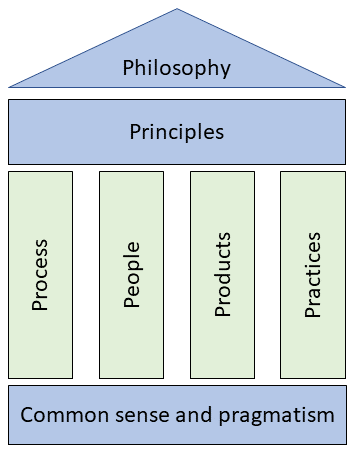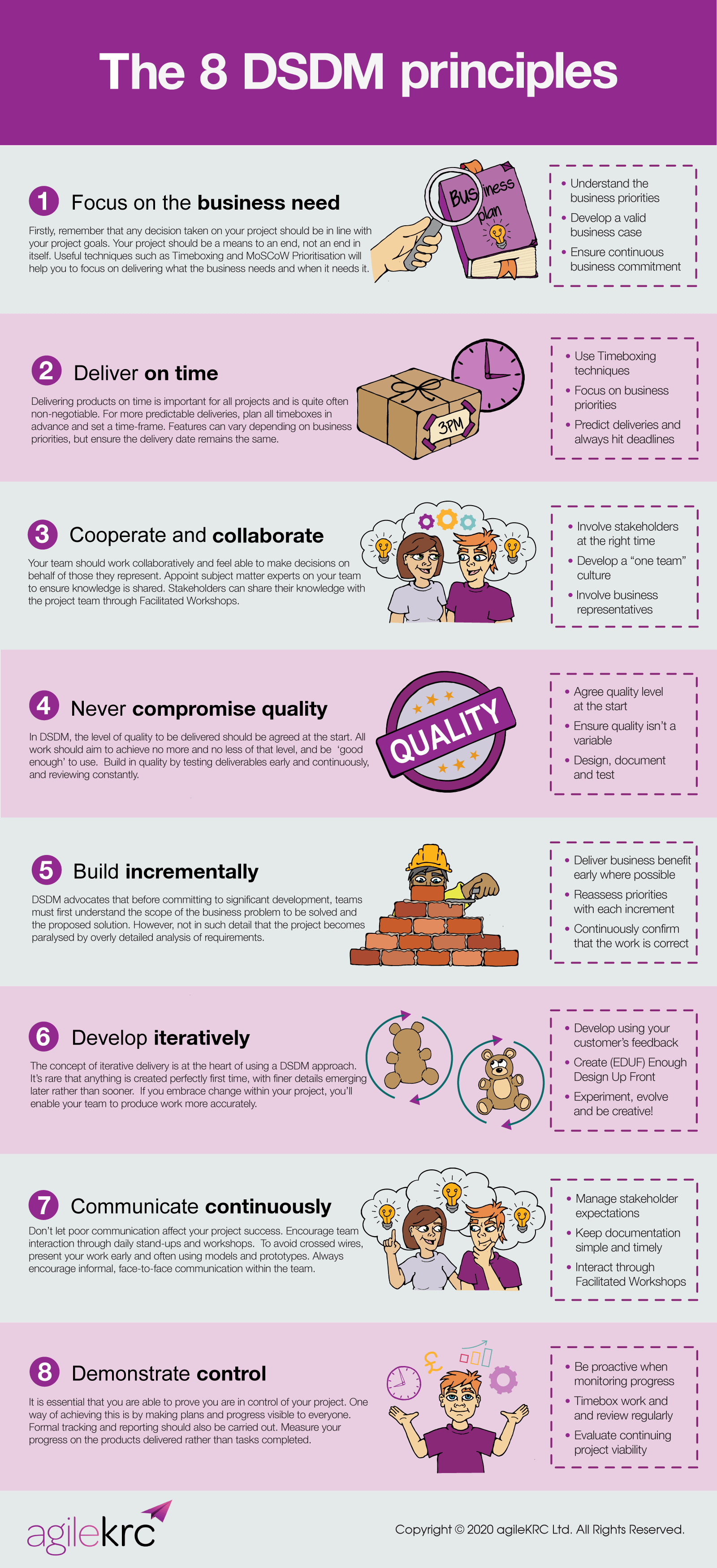
A Brief History
Dynamic Systems Development Method (DSDM) is often considered an underappreciated Agile gem.
Debuting in 1995, DSDM is the most established Agile method and is the only one to prioritize managing Agile projects.
In the early 2000s, DSDM became a sought-after Agile approach among software developers in search of alternatives to rapid application development (RAD) methods. A significant limitation of RAD was its poor scalability for team collaboration. DSDM resolved this issue by enabling collaboration within teams and at scale, making it one of the first Agile methodologies utilized by the software development community.
DSDM participated in the inception of the Agile Alliance and the Agile Manifesto in 2001. Its principles and philosophy played a part in shaping the Manifesto for Agile Software Development, though DSDM expands the Agile concept to more than just software.
In a nutshell, DSDM embraced Agile before the term even became popular!
Birth of DSDM Atern
In 2007, the DSDM method experienced a major update and was rebranded as DSDM Atern. The term ‘Atern’ was derived from the Arctic Tern, a bird known for its exceptional collaborative abilities and capacity to cover great distances. This metaphor was well-suited for the DSDM method’s rebranding.
By 2014, confusion regarding the term ‘Atern’ led to another update of the method. The decision was made to return to the original DSDM name, as it was universally acknowledged. As a result, DSDM and DSDM Atern are now interchangeable!
The Agile Project Framework of DSDM
In 2014, DSDM’s rebranding included the integration of the Agile Project Framework. The DSDM Agile Project Framework has emerged as the top, reliable agile approach that serves the two-fold needs of today’s organizations: governance and rigor, as well as agility and flexibility.
The Agile Project Framework in DSDM enables organizations to address frequent project dilemmas such as late deliveries, cost overruns, or unfit final deliverables.
Incorporating AgilePM in DSDM
DSDM was the first agile framework to integrate agile project management capabilities. Unlike Scrum, which is centered on product delivery during an iteration, DSDM also tackles project management aspects, setting it apart from most other agile frameworks.
DSDM’s proficiency in meeting various agile needs led to its selection as the basis for the swiftly growing AgilePM (Agile Project Management) qualifications, accredited by APMG International and the Agile Business Consortium.
DSDM – Agile Methodology
DSDM is an iterative agile framework initially created for efficiently delivering software projects. Like other agile frameworks and approaches, DSDM was developed in response to the challenging waterfall processes that dominated the software development industry during the late 20th century.
DSDM’s Rise
DSDM is now on the rise as agile methodologies mature. This rise is due to organizations needing increased rigor and control when applying agile in situations where the ‘ideal agile environment’ is absent.
DSDM is an agile method that caters to both straightforward product development projects with co-located teams and more complex projects involving multiple distributed teams across different countries and time zones. DSDM can scale up to accommodate multiple teams working in distributed settings, a feature that scaled agile frameworks have only recently begun to offer.
Facts about DSDM
Not Exclusively IT-focused
DSDM’s heritage, like most agile frameworks and methods, is rooted in the software development industry. However, agile has evolved over the past decade and is no longer limited to IT.
DSDM can easily be applied to projects other than software development projects. In fact, it can be utilized in any type of product development project. By delivering a functional product incrementally at the end of each timebox, DSDM can offer business value early in the product development lifecycle.
DSDM: Independent or Combined
The DSDM Agile Project Framework can be used either as an independent method or combined with other widely recognized project management methods such as PRINCE2, MSP, and PMI.
It is also ideal as a wrapper for more limited Agile approaches like Scrum, ensuring that the entire project lifecycle is addressed. DSDM also allows Scrum to be scaled up for purposes beyond just product development.
DSDM Components

DSDM is an agile project framework that incorporates several facets:
- principles
- philosophy
- process
- people
- products
- practices
- pragmatism and common sense.
These facets together encourage a philosophy of delivering business benefits as soon as possible, ensuring the greatest return on investment (ROI) for an organization.
DSDM’s ‘practicality and common sense’ might appear peculiar to some, but this flexibility helps DSDM avoid the dogmatism that can sometimes plague other Agile approaches.
A basic principle of DSDM is that nothing is built perfectly during the first attempt. As a general guideline, 80% of a solution’s value can be delivered for 20% of the effort required to produce the complete solution.
By focusing on the business need, DSDM supports projects that strategically align with an organization’s change portfolio.
DSDM Principles
DSDM encompasses 8 essential principles that define its character, culture, and mode of operation. These principles must be actively maintained throughout a project because compromising any principle can endanger the successful execution and completion of a project.
DSDM closely follows agile principles, centering on delivery, effective communication, collaboration, and continuous delivery. All DSDM principles help to integrate DSDM practices with the agile philosophy.
Learning the guiding principles of DSDM is critical if you aim to take an agile project management course like AgilePM®, which is founded on the DSDM method.
We will now look at the 8 DSDM principles.
1. Focus on the business need
- Understand business priorities.
- Create a valid business case.
- Enable continuous business commitment.
All decisions made throughout your project should coincide with overall project objectives. Projects should function as a means to reach long-term business goals. Using techniques like MoSCoW and timeboxing help to maintain focus on delivering what businesses need, exactly when they need it.
2. Deliver on time
- Use timeboxing.
- Focus on priorities.
- Predict deliveries.
Meeting product delivery schedules is typically vital. To guarantee reliable deliveries, prearrange all timeboxes. Even if features change, delivery dates need to always remain unchanged.
3. Cooperate and collaborate
- Promote stakeholder collaboration.
- Focus on team building.
- Work with business representatives.
Teams need the capacity to collaborate and decide for the people they advocate for. Integrate subject matter experts into your team to enable effective information sharing. Stakeholders may relay their knowledge and firsthand experiences to project teams through ongoing workshops.
4. Never compromise quality
- Set quality level at the start.
- Ensure quality doesn’t vary.
- Document and test.
Agree on the level of quality to be achieved from the outset. All activities should be geared towards meeting this specified level. Examine deliverables early and perpetually reassess them.
5. Build incrementally
- Deliver business benefit early.
- Reassess priorities with each iteration.
- Confirm that the work is correct.
DSDM prescribes that teams must first establish a clear understanding of the business problem’s scope before embarking on development. Avoid getting caught up in excessive requirements analysis, which may impede development.
6. Develop iteratively
- Use customer feedback.
- Create Enough Design Up Front (EDUP).
- Evolve and be creative.
The principle of iterative delivery is fundamental to DSDM. Keep in mind that it’s rare to achieve perfection at the outset, and being willing to incorporate changes in your project is crucial for success.
7. Communicate continuously
- Manage expectations.
- Keep documentation simple.
- Interact through workshops.
Facilitate team involvement by holding stand-ups and workshops. Exhibit your work regularly with the help of models and prototypes. Constantly endorse informal, face-to-face discussions among team members.
8. Demonstrate control
- Be proactive.
- Timebox work and review regularly.
- Evaluate project viability.
Elevate project supervision by ensuring everyone can view plans and progress. Follow formal documentation protocols. Measure progress by examining the products delivered instead of tasks finalized.
Processes
DSDM is both an iterative and incremental framework. It prioritizes the delivery of the most significant business needs first, with less important ones following later.
The iterative nature of DSDM allows business representatives to examine a solution as it progresses, offer their input, and request changes throughout its advancement.
Phases
The DSDM process model encompasses 6 phases. Its unique pre-project phase and post-project phase differentiate it from many other Agile approaches that only emphasize delivery.
The DSDM phases are:
- Pre-project.
- Feasibility.
- Foundations.
- Evolutionary development.
- Deployment.
- Post-project.
People
DSDM involves individuals from the realms of business and development during the entire iterative and incremental life cycle.
All project participants are assigned specific roles and duties and collaborate in timeboxes to keep the project moving forward.
The project manager’s role is distinctly detailed in DSDM, setting it apart from other Agile methods.
Practices
DSDM outlines 4 critical practices.
Timeboxing
Like numerous agile frameworks, DSDM arranges work in fixed time segments (timeboxes), much like Scrum’s sprints. The intention is to yield a functional product after each iteration (timebox). Thus, DSDM implements both an incremental and iterative approach to product development.
Facilitated workshops
Facilitated workshops bring project stakeholders together to collaborate on defining business requirements and enhancing mutual understanding.
Modelling and iterative development
Modelling enables team members to visualize a business domain and deepen their comprehension of it. Modelling is utilized for crafting diagrammatic representations of particular aspects of the system or business area in development.
DSDM depends on a brief feedback loop with the client to deliver a working software increment at the end of each iteration. The MoSCoW prioritization technique is suggested for determining the requirements the team should work on during a timebox. Requirements are usually presented as user stories.
DSDM also adopts prototyping, focusing on rapid construction, quick feedback, and early issue identification. The underlying DSDM philosophy emphasizes discovering and addressing problems as early as possible.
MoSCoW prioritization
The MoSCoW prioritization approach aids businesses in sorting requirements by identifying Must have, Should have, Could have, and Won’t have requirements for each timebox.
Understanding DSDM and Scrum
There is a common misconception in the Agile community that Scrum serves as a project management approach. In reality, Scrum is a development method that promotes team collaboration on project and non-project work in order to iteratively deliver valuable products to customers.
Scrum does not cover the activities that take place before a project (pre-project) or after the solution is in place (post-project). The pre-project phase involves evaluating the project’s viability, while the post-project phase focuses on measuring the solution’s benefits and determining any needed improvements.
In contrast, DSDM discusses the pre-project and post-project stages and defines the project manager’s responsibilities. DSDM functions as an agile project management framework, while Scrum is a product delivery framework. It’s important to note that Scrum can be used within DSDM projects during the remaining four project stages.
DSDM infographic
The following infographic shows the DSDM principles in greater detail.

Summary
The DSDM Agile Project Framework offers a dependable and proven method for agile project delivery, having been effectively applied to a multitude of projects around the world. As it stands, DSDM is the only existing agile project management framework.
The framework has consistently proven its ability to operate within and enhance existing corporate processes.
DSDM has been used in IT and non-IT projects since 1994, delivering considerable productivity gains, as independently confirmed by the UK Software Metrics Association.
For additional information on how DSDM can assist your Agile project delivery, or for details about agile project management training, please get in touch with us at agileKRC.
agileKRC has helped shape agile thinking by leading the teams that developed AgilePM® and PRINCE2 Agile®. We take a practical, success-oriented approach. We begin by taking the time to listen and understand your needs, before offering our real-world experience and expert guidance.













